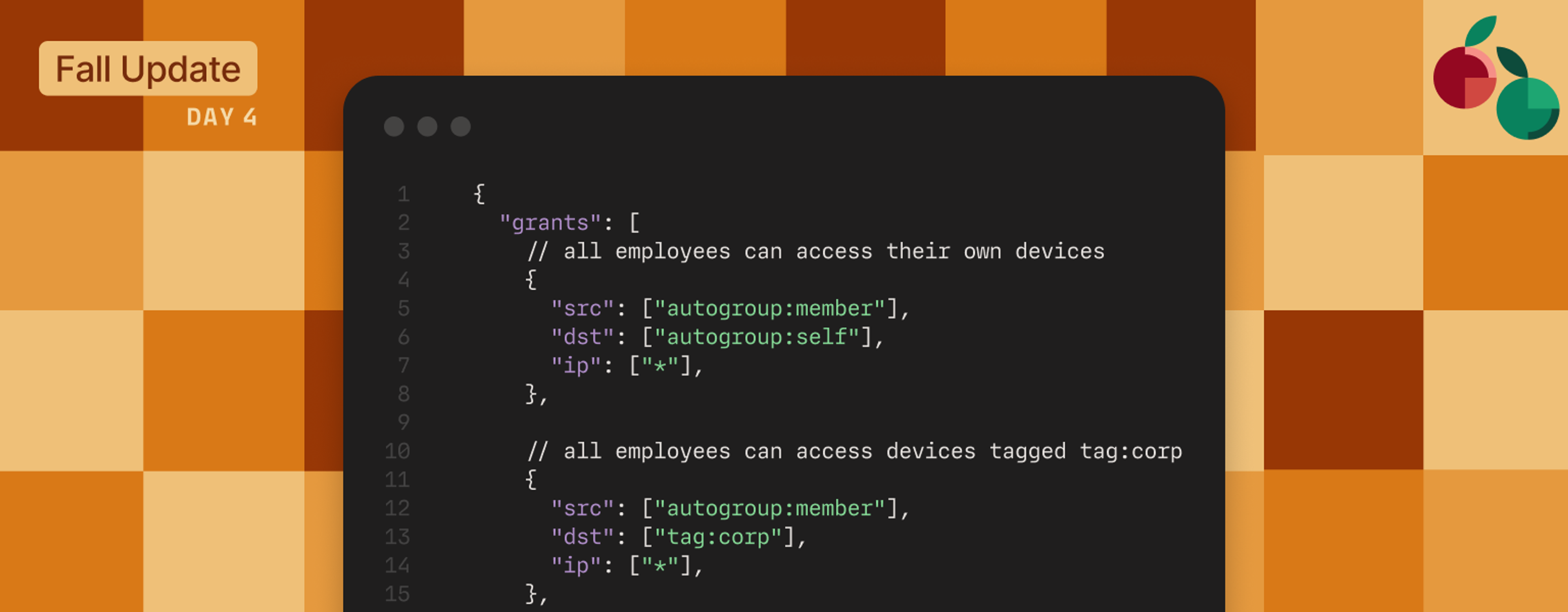Tailscale’s identity-based access controls allow for building powerful, secure applications on entirely private tailnets. You can already leverage user identity with our Go-based tsnet. Now we’re building on our prior work and taking it a significant step further, with Tailscale app capabilities. With the latest version of Tailscale’s serve function, third-party applications can accept grants through standard HTTP headers, in whatever language suits your needs.
Customers have told us they want to go beyond basic authentication in building apps on their tailnet. At the same time, they don’t want to be restricted to the coding languages that have an existing Tailscale client library, or have to write custom code to understand more about who is connecting to their apps, and what they can do.
With app capabilities, that means building your app in whatever language you prefer, and still taking advantage of Tailscale’s rich identity offerings. That unlocks tools like:
- Single applications on a tailnet that provide granular access to different teams or customers
- Dashboards and administration panels that automatically shift their displays and functions based on group membership
- Tailscale-based authorization in any application, without needing specific SDKs or integrations.
By choosing the neutral platform of HTTP headers, we can expand the types of applications with which Tailscale can interact and improve upon. We can also relieve developers of some future-proofing grief. If tsnet or other Tailscale tools are released for other languages, your app that uses serve-based headers still works, and should not need to be re-engineered.
How it works
Enabling your Tailscale serve sessions to consume grants and other capabilities is opt-in, unlocked with a flag on the serve command, --accept-app-caps, specifying the name of the application capability (or multiple names as a comma-separated list) you want to receive:
tailscale serve --accept-app-caps example.com/cap/someapp
Once enabled, serve will look up the capabilities of the peer that makes each request, select the capabilities requested in the command line, and then forward them in a header named Tailscale-App-Capabilities.
Here’s an example ACL, providing Alice and Bob with different capabilities:
{
"grants": [
{
"src": ["user:alice@example.com"],
"dst": ["someapp"],
"app": {
"example.com/cap/someapp": [{
"action": ["*"],
"resources": ["*"]
}]
}
},
{
"src": ["user:bob@example.com"],
"dst": ["someapp"],
"app": {
"example.com/cap/someapp": [{
"action": ["list_devices"],
"resources": ["bootstrap://status", "tailscale://devices"]
}]
}
}
]
}Should Alice (alice@example.com) make a request of a node that has serve running, the resulting header looks like this:
Tailscale-App-Capabilities: {"example.com/cap/someapp":[{"action": ["*"],"resources":["*"]}]}
Bob, in turn, gets back this:
Tailscale-App-Capabilities: {"example.com/cap/someapp":[{"action": ["list_devices"],"resources":["bootstrap://status","tailscale://devices"]}]}
Some HTTP servers enforce a limit on overall HTTP header size. Adding app capabilities does grow the header to a larger size than serve currently transmits. But after an analysis of existing customer header policies, capability-enabled headers should stay well within the limit (typically around 8 KB).
CLI for now, declarative coming soon
You might have seen the new Services feature we rolled out, in beta, earlier this week. We’re planning on making app capabilities available through a declarative service configuration, rather than individually configuring endpoints via serve CLI flags.
App capabilities are available in the latest unstable builds of Tailscale right now, and will be available in the coming 1.92 stable release. We’re looking forward to seeing what gets built with secure, flexible identity and permissions built right into your apps. If you have feedback, please send it our way via GitHub Issues, Reddit, or our Discord community.


 Kevin Purdy
Kevin Purdy




